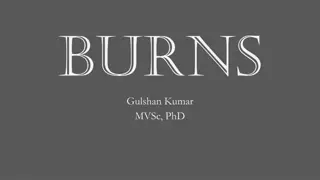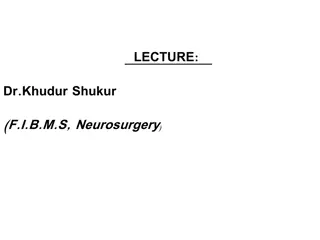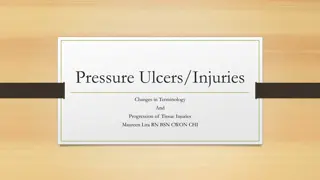Overview of Burn and Scald Injuries and Classification
Burn injuries from dry heat and scald injuries from hot liquids or steam are common forms of thermal injuries. Other etiological classifications include exposure to chemicals, electrical energy, and radiation. The extent of tissue damage is directly related to temperature and duration. Classification based on dermal layers involved and wound characteristics help in understanding the severity of burns. Degrees of burns range from superficial redness to full-thickness destruction of skin layers. Understanding these classifications is crucial for appropriate treatment and healing.
Download Presentation

Please find below an Image/Link to download the presentation.
The content on the website is provided AS IS for your information and personal use only. It may not be sold, licensed, or shared on other websites without obtaining consent from the author. Download presentation by click this link. If you encounter any issues during the download, it is possible that the publisher has removed the file from their server.
E N D
Presentation Transcript
Burn is thermal injury by dry heat Scald is thermal injury by hot liquids and stream. Scalding is more common then burns Etiological classification (1) tissue exposure to temperature extremes sufficient to cause cellular damage (2) exposure to chemicals reactivity (or secondary thermal effects) results in chemical burns; (3) electrical energy passes through the patient, causing cellular necrosis along its path; and (4) radiation at levels that cause acute cell death, an injury that is most commonly seen from exposure to solar radiation or as a side effect of radiation therapy for neoplastic disease. Etiological classification temperature extremes (either high or low) chemicals that cause tissue necrosis via chemical electrical burns occur when an electrical current of sufficient (3) radiation burns are caused by exposure to ionizing radiation (4)
a flame or fire or direct contact with a hot object scalds from hot liquids or steam extent of tissue damage is directly related to temperature and duration. At 40 to 44 C, failure of the cell membrane sodium pump occurs; epidermal necrosis (partial-thickness burn) occurs if the skin temperature reaches 60 C for one second; skin temperatures above 70 C result in full- thickness burns in less than 1 second.
Class Class Dermal layers involved Epidermis Dermal layers involved Wound characteristic Wound characteristic Healing Healing Superficial Aka 1 1st stD D Red desquamation, dry flaky look 3-5 days re- epithelization, little scar 2-3 weeks, surgical intervention to avoid big scar Surgical intervention needed Superficial partial thickness Aka 2 2nd Full thickness Aka 3 3rd Epidermis + 1/3 dermis Blisters eschar (leathery surface of dead tissue) Blisters, little scar, edema, ndD D Epidermis, dermis, s/c tissue Bloodless, white, eschar, hairs easily come off rdD D
1stDegree: Erythema or simple redness with superficial inflammation and slight swelling, may subside 2ndDegree: Vesicle formation with acute inflammation. Skin blackened and hair is singed. Superficial layers of the epithelium are destroyed. Scars not present after healing 3rdDegree: Destruction of cuticle and part of true skin. Very painful, nerve endings exposed. Healing may leaves scar. 4thDegree: Whole skin is destroyed with formation of slough (yellowish- brown/parchment-like). Surface is ulcerated and on healing a dense fibrous scar tissue develop. Scar may subsequently contract and cause deformity of the part. Not painful: complete destruction of the nerve endings. 5thDegree: Deep fascia and muscles involved. Severe scarring effect and deformity. 6thDegree: Carbonization or Charring of the limb involving subjacent tissues, organs, and bone
Zone of coagulation destruction): Inner most zone no viable tissue remains in this zone. The zone of ischemia or stasis of vascular luminal diameter from increased interstitial pressure secondary to increased capillary permeability. Increased capillary permeability depends on the severity of the burn: in a canine model of scald burns, local lymph flow and protein content increased proportionally with scald temperature. Tissues in the zone of stasis are vulnerable; whereas further insult leads to necrosis, effective therapy can restore perfusion and maintain viability. Zone of congestion or hyperemia the inflammatory response to the burn. Tissues in the zone of hyperemia are viable and heal if no further injury is sustained Zone of coagulation (aka zone of necrosis or zone of The zone of ischemia or stasis: Decreased perfusion, reduction Zone of congestion or hyperemia, which is the primary area of Mnemonic .CIC Coagulation Ischemia Congestion
Electrical injuries in animals occur most often accidentally Severity depends on type of circuit, voltage, current and duration of exposure and conditions of the animal e.g. wet or dry hair coat and pathway of current through the body. Lesions may be absent or may include early or localized rigor mortis, acute circulatory failure, or severe thermoelectrical burns. Signs include external current marks, singed hair or feathers, metallization of the skin rarely internal electroporation injury (muscle necrosis, hemolysis, vascular damage with thrombosis), injury to brain and spinal cord, or skeletal fractures. Lightning strike in animals may cause no lesions, external signs of linear or punctate burns, keraunographic markings (markings simulating the surroundings myth?), or exit burns on the soles of the hooves or the coronary bands.
effect on keratinocytes Pro-inflammatory cytokine release monocyte and macrophage activation 1. nociceptor stimulation and pain 2. increased vascular permeability 3. vasodilation 1. 2. 3. 4. 5. interstitial edema hypotension blistering warmth blanching erythema
Superficial burn changes and Destruction of blood vessels dry non blanching inelastic surface moist injury-blister rupture low sensation non blanching edema Dry All parts of skin and SC involved No sensation Fluid shift from intravascular to interstitium Hypotension Shock
General physical condition, systemic compromise, amount of body and surface affected, plus degree of local injury. If the loss of skin is large enough, euthanasia can be recommended. Special attention ..facial,eyes and perineal burn Rule of nine (9 for head/neck, chest/abdomen (front and back), 9 arms, 9 for front of the leg, 9 for back of the leg and 1% for perineum .rule of 11 (?) Card area
Airway, breathing, circulation Direct cold application .irrigation or packs Potassium .hyperkalemia due to cell destruction, hypoptoteinemia <3 Analgesics .opioid or morphine Hair clipping (?), wound cleaning to remove necrotic part and FB Antiseptics povidone or chlorhexidine sol Manage shock Systemic antibiotics do not penetrate scar, topical therapy with antibiotic ointments and creams. Gentamycin, polymyxin, neomycin, and bacitracin, fluoroquinolones, silver sulphadiazine cream. Aloe vera shows certain anti-prostaglandin effects and helps to maintain normal dermal vasculature
Transition from flow phase of shock to the hypermetabolic phase. Pulmonary problems..cough laryngoscopy intubation oxygenation. Antibiobitcs for bacterial tracheobronchitis hemodynamic stability .evaporation loss . Fluids with 5% glucose with small amount of sodium are indicated, because no major losses of sodium occur during this stage. Non-aggressive fluid therapy is currently indicated with end goals of 60 70 mm Hg as MAP, urine production around 1 2 ml/kg/hour. Albumin level around 2,5 g/dL is the goal, and hematocrit should be kept over 30%, considering whole blood transfusion renal function fluid and diuretics. Electrolyte profile burn wounds care .. . Wound cleaning, excision, and escharectomy are regular procedures and can be used to obtain proper samples for culture pain and anxiety control morphine, oxymorphone, butorphanol and low doses of benzodiazepines could be used. Phenothiazines must be avoided because of their extrapyramidal side effects in burn patients.
Inflammation-Infection Period After 1 week Sepsis, systemic inflammatory response syndrome (SIRS) and septic shock are common during this period. Adequate nutritional support is very important to clinical outcome. Feeding tubes are first choices in starving animals (pharyngostomy tube in dogs) Pulmonary infections and RADS (Respiratory Acute Distress Syndrome) remain as major causes of mortality during this period. Partial ventilatory support could be useful if necessary.
Agent Indication Effectiveness Decreased colonization of wounds Alleviates pain Broad spectrum Stronger antimicrobial activity, longer duration of action than silver sulfadiazine Ease of application and of removal Painless Frequent dressing changes CI Silver sulfadiazine (1% cream) with or without cerium Small, medium, and large surface area burns Burns near eyes Signs of reepithelialization Small, medium, and large surface area burns Burns near eyes Pregnancy Allergic to silver Silver containing dressings Small surface area burns, Face, Ears Perineum, Graft sites Bacterial resistance Signs of reepithelialization Bacitracin ointment 500 units/gram
Agent Indication Effectiveness Ease of application and of removal Painless Frequent dressing changes G +ve converage includes methicillin- resistant Staphylococc us aureus (MRSA) Ease of application and of removal, Painless Frequent dressing changes Excellent eschar penetration Penetrates cartilage G -ve coverage includes Pseudomonas CI Combination antibiotic ointment (eg, bacitracin, neomycin, and polymyxin B) Bacterial resistance Allergic reaction Signs of reepithelialization Small surface area burns, Face, Ears Perineum, Graft sites Bacterial resistance Allergic reaction Signs of reepithelialization Small surface area burns, Face, Ears Perineum, Graft sites Mupirocin ointment/cream 2% Burns >40% total body surface area Allergic to sulfonamides Ears, Nose Dense bacterial proliferation Mafenide (8.5% cream, 5% solution)
Agent Indication Effectiveness Does not interfere with reepithelialization Can be used with silver sulfadiazine Generally used as a cleansing agent CI Deep burns Caution in neonates rare association with cutaneous burns Chlorhexidine Only superficial burns Thyroid disorders Signs of reepithelialization Small, medium surface area burns Only when no other agent is available Povidone-iodine Antiseptic, topical agent often used in a diluted form as an adjunct in the setting of Pseudomonas aeruginosa Gram-negative bacteria including P. aeruginosa Superficial burns have been described from misuse Acetic acid
For extensive area application in farm animals For extensive area application in farm animals Coconut oil - camphor (10:1 to 20:1) Camphor sesame oil honey (1:1:1) Aloe Honey coconut oil (1:1) Aloe vera vera carrot carrot cucumber paste cucumber paste (1:1:1)
The initial assessmentconsider euthanasia in very large area burns Check for oral, nasal burn, perineum burn entubate and catheterize if needed 100% oxygen @ 100-150 ml/Kg/ per minute if smoke inhalation is known. Entubate. SPO2 measurement fails to distinguish between oxygenated hemoglobin and carboxyhemoglobin not reliable (ABG!) Pain relief with cold water, soak towels. NSAIDs/butorphanol for farm animals, neuroleptanalgesia in dogs, Diazepam Ketamine in cats Fluid replacement at upto 4 ml/Kg per hour. Lactated Ringer s or normal Saline is the first choice (No Free glucose fluids because of hyperglycemia and glucosuria after deep burns). Increased K+due to cells damage in first 24 hours. Monitor Check serum protein, urine production, hematocrit, hemoglobin, electrolytes and blood gases. If total protein drops below 3 gm/dl, fresh plasma or colloids should be added. Correct aidosis with sodabicarb 5 mEq/Kg of bwt every 30-60 minutes. For HCT <20% or Hb falls below 7 gm/dl consider blood transfusion (Hct > 30% is the goal) Initiate local wound care and manage complications Consider grafting, manage special location burns like udder etc (ABG!)
Parameter/effect Parameter/effect
Parameter/effect Parameter/effect
Burn injury management Management of pulmonary edema Electric cord bites in dogs Signs include oral ulcerations, singeing of the fur, cough, tachypnea, open mouth breathing, mucus membranes cyanosis, crackling sound when breathing, excess salivation, difficulty in swallowing and restlessness. Supportive treatment .crystalloid, colloid, diuretics (for pulmonary edema), pain management.
Ammonia Battery acid Bleach Concrete mix Drain or toilet bowl cleaners Metal cleaners Caustic soda Phenol Halogenated acids e.g. HCl, HF
Chemical burns are more severe than thermal Alkali burns are more severe than acid All signs CIC .present Systemic absorption and toxic effects may occur in phenol burn and HF Accidental or malafide
Prolonged rinsing to wash off.most effective Nutralization with weak acetic acid (5%) or milk or carbonated water. Treatment similar to burn Systemic effects of phenol and HF can occur in addition to local burn lesion. Signs of phenol toxicity include convulsions, sudden collapse, coma, nausea, vomiting, diarrhea, methemoglobinemia, hemolytic anemia, profuse sweating, hypotension, arrhythmia, pulmonary edema, and tachycardia. Signs of HF toxicity may include Drooling, Breathing difficulty, Abdominal pain, Hematemesis, Collapse (from low blood pressure or shock) and Irregular heartbeat. Supportive and symptomatic treatment most effective
Identified by redness, intense irritation, blisters and bleeding Treatment consists of wound care.. cooling .removal of shreds astringents (keolin paste/Caladryl lotion) aloe vera paste Pain management Antimicrobial therapy
Cause is prolonged low temperature exposurecommon parts are ears, paw, foot, tail or even skin coat Cold exposure <00C causes the blood vessels near the skin to narrow. Predisposing causes are heart disease or diabetes mellitus, wet fur, short hair, small size, illness or old age. At extremely low temperature intracellular water freezes, microvascular circulation fails and cells rupture and ulcers may form Damage degrees similar to burns
Warm water bath (warm (37-39 C) not Hot) No rubbing, no hot air blow, no heating Once the area has been thawed any dead tissue that remains will need to be removed surgically. Topical treatments anti-inflammatories, aloe vera gel, and nitroglycerin (to increase blood circulation to the area) may be recommended during healing of the wounds Calcium channel blockers and vasodilators may be considered (amlodipine/nifedipine) Surgical intervention if gangrene dry .supervenes























